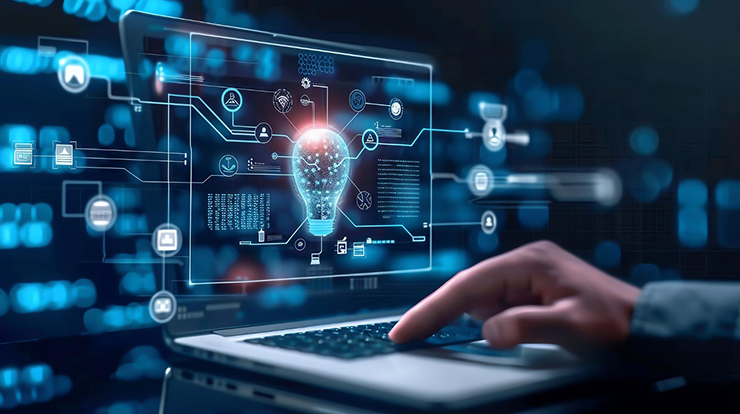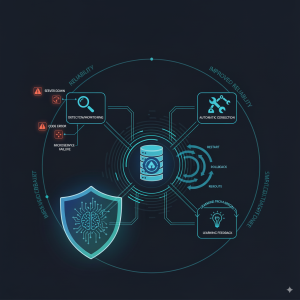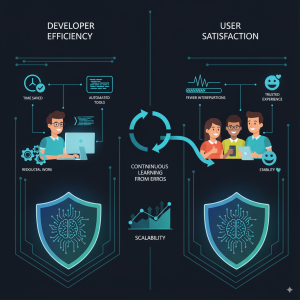
Have you ever faced a software crash at the worst possible time? It can ruin work, delay projects, and create stress. Now imagine software that can detect problems and fix them on its own. This is not science fiction. The self-healing software is already changing how we develop and test the applications. It simplifies software, makes it more intelligent and dependable. This technology is beneficial to both businesses, developers, and users.
Contents
Why Do We Need Self-Healing Software?
Software errors are very common. Bugs, system crashes, and downtime can cost companies a lot of money. Fixing these issues takes time and effort. Another reason is that developers may take hours to identify the cause of a problem and fix it. This is minimized by self-healing software.
The following are some of the reasons why business organizations require self-healing software:
- Reduced downtime: The applications can be operated even when small errors occur.
- Faster recovery: Problems are solved automatically without waiting for human intervention.
- Improved user experience: Customers experience fewer interruptions and have improved applications.
- Savings on cost: The reduced amount of work by hand reduces operational costs.
What Exactly Is Self-Healing Software?
Self-healing software can detect issues in real time. It realizes something that was not done right and corrects the issue automatically. That can be achieved with the help of intelligent surveillance, with the use of automated regulations, and in some cases, artificial intelligence.

For example, if a web server stops responding, the system can restart it automatically. If a code error occurs during deployment, the system can roll back to a stable version. If a microservice fails, traffic can be rerouted to healthy services without downtime. The software can also learn from past errors. This means repeated problems are less likely to happen. Over time, applications become more resilient and smarter.
Also Read – How the Web Design and Development Landscape Evolves in the Future
How Does It Work?
Self-healing software works in three main steps. To begin with, it monitors errors and abnormal behavior in systems at all times. Second, it finds the root of any issue by logs, metrics, or AI models. Third, it will automatically act to correct the problem or alert a human being, where necessary. Artificial intelligence plays a key role in predicting failures before they happen. This approach is already used in industries like cloud computing and e-commerce.
- Netflix Chaos Monkey: Randomly disables servers to test if the system can self-recover.
- AWS Auto Scaling: Automatically replaces unhealthy servers to maintain performance.
- Database replication: Systems like PostgreSQL or MongoDB automatically switch to a backup if the primary server fails.
These examples show how self-healing software is applied in real-world scenarios.
When Can We Use Self-Healing Software?
Self-healing software can be used almost anywhere. It is especially useful in environments where reliability matters most. This includes cloud applications, websites, mobile apps, and enterprise systems. Small businesses can benefit too. Even a few minutes of downtime can affect sales or customer satisfaction. Self-healing software ensures smooth operations.
They may be applied in practice, like e-commerce sites that keep checkout systems when traffic is high or bank apps that allow transactions to be executed even when a server is unavailable, and using SaaS that automatically deals with small bugs without informing users.
Benefits for Developers and Users
Self-healing software saves developers time. They spend less effort monitoring systems and fixing repetitive errors. Instead, they can focus on building new features and improving products.

For users, the benefits are clear. There are fewer interruptions and more reliable applications. The system runs smoothly, which improves trust and satisfaction. Other benefits are that software can also improve through learning, and its improvement is based on previous problems; scalability, whereby new systems can accommodate an increased number of users and can be deployed quickly, because the developer is sure that the software can be released.
Is Self-Healing Software Safe?
Many people ask, “Can I trust software to fix itself?” The answer is yes, with proper safeguards. Most self-healing systems include monitoring and logging. They keep a record of all automated actions. Human oversight is still important for critical changes. But for minor errors and predictable issues, self-healing software can act quickly and safely. This combination of automation and supervision makes systems both resilient and secure.
The Future of Self-Healing Software
The future of self-healing software is exciting. Artificial intelligence will make systems even smarter. Software will not only fix problems but also predict them.
Predicted benefits include:
- Reduced downtime across industries.
- AI predicting failures before they impact users.
- Faster recovery and smoother user experience.
- Developers focusing on creativity rather than constant problem-solving.
As AI improves, self-healing software may even suggest better code practices, detect vulnerabilities automatically, and optimize system performance on its own.
How to Get Started
Getting started is easier than it sounds. First, monitor your applications closely. Next, use tools that detect errors in real time. Start with simple automated fixes. Gradually introduce AI-based fixes as confidence grows. Test the system carefully before applying it to critical areas. In the long run, you will realize that the downtime will be lowered and reliability will be enhanced.
Self-healing software could be applied in businesses by tracking the key systems, automating minor fixes, introducing AI for fixing and error prevention, and reviewing the performance of the systems on a constant basis. By following these steps, downtime is minimized, user experience improves, and developers can focus on innovation.
Conclusion
Self-healing software is the future of development. It solves problems automatically and learns from them. It saves time, reduces errors, and improves user experience. Software manages itself, and developers are able to concentrate on innovation. Whether to adopt it or not is not the question, but when. Flex it to the smartest, quickest, and most reliable software every day. The future is here, and self-healing software is leading the way.




